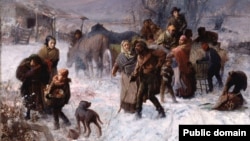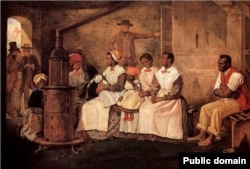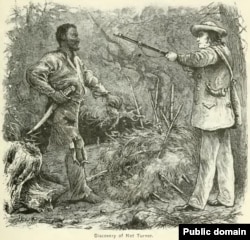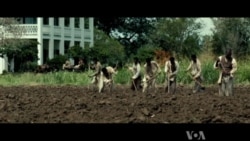From VOA Learning English, welcome to The Making of a Nation, our weekly program of American history for people learning American English. I’m Steve Ember in Washington.
We have been talking about the Compromise of 1850. In September of that year, the United States Congress passed five bills that sought to settle the issue of slavery. All five became law after the president signed them.
Owning another human being was legal in many parts of the U.S. at that time. Most American slaves or their ancestors originally came from Africa. Many slaves worked for white landowners in cotton or tobacco fields. Some, like Phoebe Boyd of Virginia, worked in the family’s home.
“Had to clean up, and set the table, tote in the eating.”
That recording comes from the Voices from the Days of Slavery Project at the U.S. Library of Congress. Ms. Boyd was speaking in 1935, remembering her childhood as a slave. She said she had to clean up, set the table, carry the food, and, afterwards, prepare the bed.
Harriet Smith of Texas was another former slave. She said in a 1941 recording that she did not go to school.
“Nuh huh. Uh, uh, they didn't know nothing about reading and writing. All that I knowed they teach you is mind your master and your mistress.”
Aunt Harriet, as she was called, said she did not know anything about reading or writing. She said she was taught only to obey the slave owners.
Slaves were considered property, like farm animals or furniture. Slave owners could do anything they wanted with their slaves — including separate them from their families, sexually abuse them, hurt or even kill them.
Harriet Smith said her owners treated her well. But she heard about slaves who were mistreated.
“Yes, I know of times they, when, when they mistreated people, they did, and I hear our folks talk, you know, about them whipping, you know, till they had to grease their back to take the holes from the, the back.”
Some slaves were beaten so badly, she said, they had to repair the holes in their backs with grease.
By 1804, all Northern states had banned slavery. But northern whites still did not accept blacks as their equals.
And slavery was still legal in Southern states for most of the 1800s. Slave owners there said they needed slaves to work on large farms or for other economic reasons.
But other Americans said slavery was immoral. Or that it gave the South the unfair competitive edge of low-cost labor. The Compromise of 1850, then, attempted to balance the desires of those who supported and those who opposed slavery.
Politicians were not the only ones who struggled with the issue of slavery in the United States. Slaves, for example, had been fighting the system for some time.
Many slaves resisted their owners in small ways. They broke or hid tools. Or they worked slowly or claimed to be sick, even when they were not.
A few answered the violence of slavery with violence. They planned — but rarely succeeded — to kill their masters and escape.
A man named Nat Turner led one of the best known slave rebellions. Turner was born in 1800 in the slave state of Virginia. Unlike most slaves, he could read. He also believed that God had given him a special purpose.
In 1831, Turner saw what he described as a sign from above. The sign told him it was time to rebel against slavery. He gathered several men and, in the middle of the night, killed his master and his master’s family in their beds.
Turner and his men continued to another house, and then another. They killed every white person they found. Other slaves saw what was happening and joined Turner. By the end of the raids, 40 blacks had stabbed, beaten, or shot to death an estimated 55 whites.
A local white militia moved to stop Turner and his group. Almost all the attackers were captured quickly. Some were killed. Others were sold and sent away from their families.
But Nat Turner escaped capture. For a month he hid around his master’s farm. Finally someone found him. Turner was jailed, tried, sentenced, and hanged. After he died, his killers pulled off his skin and removed his head.
The historian Henry Louis Gates, Jr. studied Nat Turner’s slave rebellion. He wrote that blacks remembered Turner for his personal war against slavery, his violent methods, and his harsh treatment after death. But whites had a different reaction. Frightened white mobs killed another 200 blacks to answer the rebellion. Most of these blacks had no part in the rebellion.
After Nat Turner’s rebellion the state of Virginia passed stronger laws to control slaves. The legislation included bans on reading, gathering, and traveling.
Even with stronger laws in place, many slaves continued taking huge risks in an effort to win their freedom. From about the end of 1700s to the middle of the 1800s, thousands escaped slavery on what came to be called the "Underground Railroad."
The Underground Railroad was not a real railroad. It was a group of people, both blacks and whites, who secretly helped slaves escape to the North.
Members of the Underground Railroad helped slaves leave the places where they lived and worked. These “conductors” took the escaping slaves to a safe house or business, called a “station.”
“Stationmasters” hid the escaped slave. Then at night, a different conductor took him or her to another hiding place farther north. The process was repeated every day and night until the escaped slave was safe in a free state, or even in Canada.
A black woman named Harriet Tubman was perhaps the most famous conductor on the Underground Railroad. She had been born a slave around 1820. She worked first in a house, and then in the fields, for an owner in the slave state of Maryland.
Harriet Tubman was known for her bravery. One story people told about her happened when she was a teenage girl. An overseer — someone who controlled the slaves in the field — became angry with another slave. He threatened the man with a heavy weight.
Young Harriet stepped between the overseer and the other slave. The overseer threw the weight. It hit her in the head. For the rest of her life Harriet Tubman suffered from the injury. It caused headaches, strange dreams, and — from time to time — made her fall deeply asleep.
When Tubman was about 29, she suspected her owner would sell her. So she decided to escape instead. One night she secretly walked away. She walked over 200 kilometers, following the North Star. Eventually, she arrived in the city of Philadelphia in the free state of Pennsylvania.
A year later, Tubman returned to Maryland. She helped her sister and her sister’s children escape. Then she helped her brother and two other men. She helped her parents, who were over 70 years old. And she helped many others. In all, Tubman made as many as 19 trips to the South. She led about 300 slaves to freedom.
Tubman and her “passengers” were never caught. But if they had been, they would have been severely punished. Former masters were likely to beat, or cut off the hands of, escaped slaves.
The Compromise of 1850 made escaping slavery even harder. One of the bills Congress passed was the Fugitive Slave Act. It said anyone who helped a fugitive -- that is, an escaped slave -- would be fined. And, it said fugitive slaves must be returned to their owner, even if they had escaped to a free state.
Fugitive slaves had no right to a trial. Because they could not defend themselves in court, even freed blacks could be kidnapped and enslaved.
In 1852, a white woman published a book about slavery. She called it "Uncle Tom's Cabin."
Harriet Beecher Stowe wrote the book for one reason. She wanted to show how cruel slavery was. Fugitive slaves also published books about their experiences. The stories painted a picture of slavery that most people in the North had never seen. They were shocked. Public pressure to end slavery grew stronger.
Anti-slavery activists called Abolitionists wanted to free all slaves immediately. But even if that could be done, there was the question of what to do with the freed slaves. In many places, it seemed impossible that blacks and whites could live together peacefully and in freedom. The best answer, some people thought, was to free the slaves and help them return to Africa.
It was not a new idea. In the early 1800s, a group of leading Americans had formed an organization for that purpose. They called it the American Colonization Society.
In 1820, the Society began helping to send blacks to Africa. The blacks formed a government of their own. In 1847, they declared themselves independent. They called their new country, the Republic of Liberia. The country had a constitution like that of the United States.
By 1854, 9,000 blacks from the United States had gone to Liberia. Some had technical skills. They knew how to make iron. They knew how to use steam engines and other machinery. The American Colonization Society hoped they would use their skills to help improve life for the African people.
But it could not be denied that the plan was a way to get black people out of the United States. Many whites refused to accept the fact that most free blacks did not want to go to Africa. They had grown up in the U.S. For better or worse, it was their home.
The continuing struggle over slavery will be our story next week. I’m Steve Ember, inviting you to join us next time for The Making of a Nation — American history from VOA Learning English.











